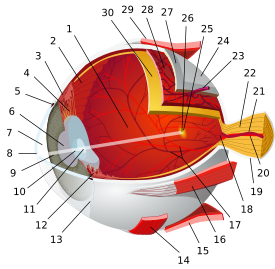- Descemet's membrane
-
Descemet's membrane 
Vertical section of human cornea from near the margin. (Waldeyer.) Magnified.
1. Epithelium.
2. Anterior elastic lamina.
3. substantia propria.
4. Posterior elastic lamina.
(Descemet's membrane)
5. Endothelium of the anterior chamber.
a. Oblique fibers in the anterior layer of the substantia propria.
b. Lamellæ the fibers of which are cut across, producing a dotted appearance.
c. Corneal corpuscles appearing fusiform in section.
d. Lamellæ the fibers of which are cut longitudinally.
e. Transition to the sclera, with more distinct fibrillation, and surmounted by a thicker epithelium.
f. Small bloodvessels cut across near the margin of the cornea.Latin l. limitans posterior corneae Gray's subject #225 1008 Descemet's membrane is the basement membrane that lies between the corneal proper substance, also called stroma, and the endothelial layer of the cornea. It is composed of a different kind of collagen (Type VIII)[1] than the stroma. The endothelial layer is located at the posterior of the cornea. Descemet's membrane, as the basement membrane for the endothelial layer, is secreted by the single layer of squamous epithelial cells that compose the endothelial layer of the cornea.
Its thickness ranges from 3 μm at birth to 8-10 μm in adults.[2]
It is also known as the Posterior limiting lamina, posterior elastic lamina, lamina elastica posterior, and membrane of Demours. It was named after French physician Jean Descemet (1732–1810).
Significant damage to the membrane may require a corneal transplant as the endothelial cells depend on it for support and cannot re-grow after injury without it.[citation needed]
See also
The corneal endothelium is a single layer of squamous cells covering the surface of the cornea that faces the anterior chamber.
References
Histology A text and atlas. Michael H.Ross and Wojciech Pawlina 5th Edition 2006
- ^ http://emedicine.medscape.com/article/1197057-overview
- ^ Johnson DH, Bourne WM, Campbell RJ: The ultrastructure of Descemet's membrane. I. Changes with age in normal cornea. Arch Ophthalmol 100:1942, 1982
External links
Sensory system – visual system – globe of eye (TA A15.2.1–6, TH 3.11.08.0-5, GA 10.1005) Fibrous tunic (outer) Episcleral layer • Schlemm's canal • Trabecular meshworkUvea/vascular tunic (middle) Retina (inner) LayersCellsPhotoreceptor cells (Cone cell, Rod cell) → (Horizontal cell) → Bipolar cell → (Amacrine cell) → Retina ganglion cell (Midget cell, Parasol cell, Bistratified cell, Giant retina ganglion cells, Photosensitive ganglion cell) → Diencephalon: P cell, M cell, K cell
Muller gliaOtherAnterior segment Posterior segment Other M: EYE
anat(g/a/p)/phys/devp/prot
noco/cong/tumr, epon
proc, drug(S1A/1E/1F/1L)
Categories:- Eye anatomy
- Eye stubs
Wikimedia Foundation. 2010.


